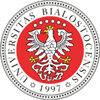Proszę używać tego identyfikatora do cytowań lub wstaw link do tej pozycji:
http://hdl.handle.net/11320/19031Pełny rekord metadanych
| Pole DC | Wartość | Język |
|---|---|---|
| dc.contributor.author | Golej, Robert | - |
| dc.contributor.author | Borowska, Magdalena | - |
| dc.contributor.author | Cieśla, Aleksandra | - |
| dc.date.accessioned | 2025-10-14T07:11:14Z | - |
| dc.date.available | 2025-10-14T07:11:14Z | - |
| dc.date.issued | 2025 | - |
| dc.identifier.citation | Optimum. Economic Studies, Nr 3(121) 2025, s. 314-340 | pl |
| dc.identifier.issn | 1506-7637 | - |
| dc.identifier.uri | http://hdl.handle.net/11320/19031 | - |
| dc.description.abstract | Purpose | The purpose of this article is to determine the impact of employer branding tools on the employee’s perception of the employer in a selected company from the financial industry Research method | In the study, the observation method and free interview were used for the initial identification of explanatory variables. The statistical method was chosen for the main part of the study. The exemptions were considered a dependent variable, in this case, and selected EB tools, such as bonuses and training, were used as explanatory variables. The survey was conducted on a sample of employees of a company from the broadly understood financial intermediation industry (30 people). Our research focuses not on the future employees, but on the current employees and those who have decided to leave their jobs. The research is preliminary. We also assess the suitability of the chosen method to achieve the set goal. Results | The results indicate that the relationship between the used EB methods, the amount of training and bonuses, and the employees’ evaluation of the employer, is statistically significant. Originality / value / implications / recommendations | We circumvented difficulty in measuring the employee’s assessment of the employer by starting from the assump tion that the extreme manifestation of dissatisfaction with an employer regards an employee’s dismissal from a job, and the extreme manifestation of a good opinion of an employer regards continuity of employment. Employers should therefore take advantage of this knowledge when building appropriate bonus systems and training employees. | pl |
| dc.description.sponsorship | This article was supported by the Ministry of Science and Higher Education as part of a grant for the development of research at the Faculty of Management, Wroclaw University of Economics and Business. | pl |
| dc.language.iso | en | pl |
| dc.publisher | Wydawnictwo Uniwersytetu w Białymstoku | pl |
| dc.subject | employer branding | pl |
| dc.subject | bonus systems | pl |
| dc.subject | training employees | pl |
| dc.subject | economy 4.0 | pl |
| dc.title | Bonuses and Training as an EB Tool in the Perspective of Economy 4.0 | pl |
| dc.type | Article | pl |
| dc.rights.holder | © Copyright by Uniwersytet w Białymstoku | pl |
| dc.identifier.doi | 10.15290/oes.2025.03.121.17 | - |
| dc.description.Email | Robert Golej: robert.golej@ue.wroc.pl | pl |
| dc.description.Email | Magdalena Borowska: magdalena.borowska@ue.wroc.pl | pl |
| dc.description.Email | Aleksandra Cieśla: aleksandraciesla1998@gmail.com | pl |
| dc.description.Affiliation | Robert Golej - Wroclaw University of Economics and Business | pl |
| dc.description.Affiliation | Magdalena Borowska - Wroclaw University of Economics and Business | pl |
| dc.description.references | Ahmad A., Khan M.N., Haque M.A., 2020, Employer Branding Aids in Enhancing Employee Attraction and Retention, “Journal of Asia-Pacific Business”, vol. 21(1), pp. 27–38. | pl |
| dc.description.references | Ambler T., Barrow S., 1996, The Employer Brand, “Journal of Brand Management”, no. 4, pp. 185–206. | pl |
| dc.description.references | Arachchige B.J.H. Robertson A., 2011, Business Student Perceptions of a Preferred Employer: A Study Identifying Determinants of Employer Branding, “IUP Journal of Brand Management”, vol. 8(3), pp. 25–46, http://search.ebscohost.com/login.aspx?direct = true&db = buh&AN = 71423489&site = ehost-live [date of access: 20.07.2024]. | pl |
| dc.description.references | Arasanmi C.N., Krishna A., 2019, Employer Branding: Perceived Organisational Support and Employee Retention – the Mediating Role of Organisational Commitment, “Industrial and Commercial Training”, vol. 51(3), pp. 174–183, DOI: 10.1108/ICT-10-2018-0086. | pl |
| dc.description.references | Armstrong M., 2020, Armstrong’s Handbook of Human Resource Management Practice (15th ed.), Kogan Page, London. | pl |
| dc.description.references | Backhaus K.B., Tikoo S., 2004, Conceptualizing and Researching Employer Branding, “Career Development International”, no. 9, pp. 501–517. | pl |
| dc.description.references | Balicki A., 2006, Analiza przeżycia i tablice wymieralności, Warszawa: PWE. | pl |
| dc.description.references | Barrow S., Mosley R., 2005, The Employer Brand: Bringing the Best of Brand Management to People at Work, John Wiley & Sons Ltd. Chichester, DOI: 10.1057/palgrave.bm.2550125. | pl |
| dc.description.references | Cable D.M., Turban D., 2003, The Value of Organizational Reputation in the Recruitment Context: a Brandequity Perspective, “Journal of Applied Social Psychology”, vol. 33(11), pp. 2244–2266, DOI: 10.1111/j.1559-1816.2003.tb01883.x. | pl |
| dc.description.references | Chandrasekaran S., 2020, Impact on Employer Branding through Talent Retention and Motivation in Insurance Companies, “ARIV – International Journal of Business Issue”, vol. 1(1), pp. 54–60. | pl |
| dc.description.references | Da Silva L.B.P., Soltovski R., Pontes J., Treinta F.T., Leitão P., Mosconi E., de Resende L.M.M., Yoshino R.T., 2022, Human Resources Management 4.0: Literature Review and Trends, “Computers and Industrial Engineering”, no. 168, pp. 1–20, DOI: 10.1016/j.cie.2022.108111. | pl |
| dc.description.references | Edwards M., 2010, An Integrative Review of Employer Branding and OB Theory, “Personnel Review”, no. 39, pp. 5–23. | pl |
| dc.description.references | Figurska I., Matuska E.W., 2013, Employer Branding as a Human Resource Management Strategy: The Essence of Employer Brand, “Human Resources Management & Ergonomics”, vol. 7(2), pp. 35–51, http://frcatel.fri.uniza.sk/hrme/files/2013/2013_2_03.pdf [date of access: 20.07.2024]. | pl |
| dc.description.references | Grzybowska W., 2022 Employer branding w kontekście budowania przewagi konkurencyjnej przedsiębiorstw–przegląd literatury, ”Academy of Management”, vol. 6(4), pp. 74–91, DOI: 10.24427/az-2022-0057. | pl |
| dc.description.references | Highhouse S., Lievens F., Sinar E.F., 2003, Measuring Attraction to Organizations, “Educational and Psychological Measurement”, vol. 63(6), pp. 986–1001. | pl |
| dc.description.references | Itam U., Misra S., Anjum H., 2020, HRD Indicators and Branding Practices: a Viewpoint on the Employer Brand Building Process, “European Journal of Training and Development”, vol. 44(6–7), pp. 675–694, DOI: 10.1108/EJTD-05-2019-0072. | pl |
| dc.description.references | Jahri M., Norjannah N., Mahyudiansyah M., 2025, Gamification in HR Management: Increasing Employee Motivation and Competence through an Interactive Approach, ”Maneggio”, vol. 2(1), pp. 80–89, DOI: 10.62872/w0408b69. | pl |
| dc.description.references | Kashyap V., Verma N., 2018, Linking Dimensions of Employer Branding and Turnover Intentions, “International Journal of Organizational Analysis”, vol. 26(2), pp. 282–295, DOI: 10.1108/IJOA-03-2017-1134. | pl |
| dc.description.references | Kimpakorn N., Tocquer G., 2009, Employees’ Commitment to Brands in the Service Sec-tor: Luxury Hotel Chains in Thailand, “Journal of Brand Management”, no. 16, pp. 532–544, DOI: 10.1057/palgrave.bm.2550140. | pl |
| dc.description.references | Kozłowski M., 2012, Employer Branding. Budowanie wizerunku pracodawcy krok po kroku, Warszawa: Oficyna. | pl |
| dc.description.references | Kucharčíková A., Tokarčíková E.,Blašková M., 2015, Human Capital Management – Aspect of the Human Capital Efficiency in University Education, “Procedia – Social and Behavioral Sciences”, no. 177, pp. 48–60, DOI: 10.1016/j.sbspro.2015.02.332. | pl |
| dc.description.references | Lievens F., Slaughter J.E., 2016, Employer Image and Employer Branding: What We Know and What We Need to Know’, “Annual Review of Organizational Psychology and Organizational Behavior”, no. 3(April), pp. 407–440, DOI: 10.1146/annurev-orgpsych-041015-062501. | pl |
| dc.description.references | Lloyd S., 2002, Branding from the Inside, “BRW”, vol. 24(10), pp. 64–66. | pl |
| dc.description.references | Madhumithaa N., Sharma A., Adabala S.K., Siddiqui S., Kothinti R.R., 2025, Leveraging AI for Personalized Employee Development: A New Era in Human Resource Management, “ACR Journal”, vol. 2(1), pp. 134–141. | pl |
| dc.description.references | Miles S.J., McCamey R., 2018, The Candidate Experience: Is It Damaging your Employer Brand?, “Business horizons”, vol. 61(5), pp. 755–764. | pl |
| dc.description.references | Mosley R., 2014, Employer Brand Management Practical Lessons from the World’s Leading Employers, Wiley. | pl |
| dc.description.references | Noe R., 2017, Employee Training and Development, McGraw Hill Education, New York. | pl |
| dc.description.references | Pološki Vokić N., Tkalac Verčič A., Sinčić Ćorić D., 2023, Strategic Internal Communication for Effective Internal Employer Branding, “Baltic Journal of Management”, vol. 18(1), pp. 19–33, DOI: 10.1108/BJM-02-2022-0070. | pl |
| dc.description.references | Rampl L.V., Opitz Ch., Welpe I.M., Kenning P., 2014, The Role of Emotions in Decision-making on Employer Brands: Insights from Functional Magnetic Resonance Imaging “fMRI”, Mark. Lett, no. 25, pp. 1–14. | pl |
| dc.description.references | Reis I., Sousa M.J., Dionísio A., 2021, Employer Branding as a Talent Management Tool: A Systematic Literature Revision, Sustainability vol. 13(19), pp. 1–22, DOI: 10.3390/su131910698. | pl |
| dc.description.references | Rosethorn H., 2009, The Employer Brand. Keeping Faith with the Deal, Gower Publishing Limited, Farnham. | pl |
| dc.description.references | Saini G.K., 2023, Employer Branding: A Critical Review and Future Research, “NHRD Network Journal”, vol. 16(3), pp. 220–32, DOI: 10.1177/26314541231170424. | pl |
| dc.description.references | Tenakwah E.S., 2021, What Do Employees Want? Halting Record-setting Turnovers Globally, “Strategic HR Review”, vol. 20(6), pp. 206–21, DOI: 10.1108/SHR-08-2021-0040. | pl |
| dc.description.references | Thomas S., Kureshi S., Suggala S., Mendonca V., 2020, HRM 4.0 and the Shifting Landscape of Employer Branding, “Human and Technological Resource Management (HTRM): New Insights into Revolution 4.0”, pp. 37–51, DOI: 10.1108/978-1-83867-223-220201003. | pl |
| dc.description.references | Vidhya P., Sundharesalingam P., 2022, Impact of Industry 4.0 on Human Resource Process, “Ushus Journal of Business Management”, vol. 21(2), 41–56, DOI: 10.12725/ujbm.59.4. | pl |
| dc.description.references | www 1, https://hrminstitute.pl/wskazniki-efektywnosci-%E2%80%A8dzialan-employer-brandingowych [date of access: 20.07.2024]. | pl |
| dc.description.references | www 2, Employer Brand Research Global Report, 2021, Randstat, https://workforcein‑sights.randstad.com/randstad-employer-brand-research-global-report-2022 [date of access: 20.07.2024]. | pl |
| dc.description.references | www 3, World’s Most Attractive Employers, 2020, Universum, https://universumglobal.com/wmae2020 [date of access: 20.07.2024]. | pl |
| dc.description.references | www 4, Employee Training Statistics, Trends, and Data in 2025, https://www.devlinpeck.com/content/employee-training-statistics?utm_source = chatgpt.com [date of access: 9.07.2025]. | pl |
| dc.description.references | www 5, Czy premie naprawdę motywują pracowników?, https://hrnews.pl/systemy-premiowe/?utm_source = chatgpt.com [date of access: 9.07.2025]. | pl |
| dc.description.number | 3(121) | pl |
| dc.description.firstpage | 314 | pl |
| dc.description.lastpage | 340 | pl |
| dc.identifier.citation2 | Optimum. Economic Studies | pl |
| dc.identifier.orcid | 0000-0003-4462-7035 | - |
| dc.identifier.orcid | 0000-0001-5627-7058 | - |
| Występuje w kolekcji(ach): | Optimum. Economic Studies, 2025, nr 3(121) | |
Pliki w tej pozycji:
| Plik | Opis | Rozmiar | Format | |
|---|---|---|---|---|
| Optimum_3_2025_R_Golej_M_Borowska_A_Ciesla_Bonuses_and_Training_as_an_EB_Tool.pdf | 364,25 kB | Adobe PDF | Otwórz |
Pozycja jest chroniona prawem autorskim (Copyright © Wszelkie prawa zastrzeżone)

